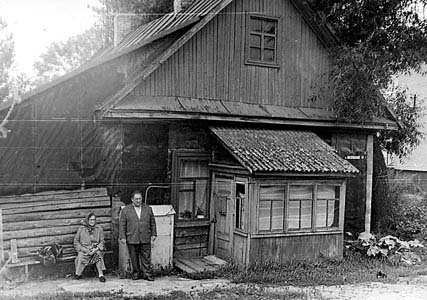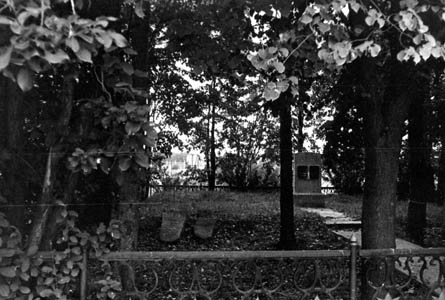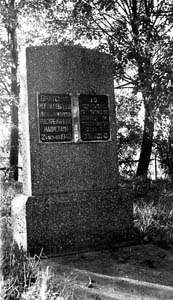“Traveling with Arkady Shulman”
FEELING SORRY FOR COWS, NOT PEOPLE.
We arrived in Miory early in the morning and went to the Tsypins – the only Jewish family in the regional center, which once used to be a Jewish shtetl.
This is the story of Sora-Riva Israilevna Tsypina.
- My maiden name was Bethen. I was born in Kraslava (now in Latvia) in 1921 and lived there till 1941. Then I evacuated to Bagulma, which was Tatar SSR. My brother was recruited to the army and fought at the battlefront. He died. In 1945 we returned to Kraslava and then I left for Riga. My husband returned from the battlefront. He was originally from Miory and told me a lot about his relatives that had been shot in Miory.
We were also visited by Srol Luminsky from the USA and he also had a lot of stories to share.
All the Jews in Miory were first locked in their houses and then forcefully taken to the square. Nazis made them stand on their knees like cattle and photographed that. Those, who were brave enough, ran away. Among them was Bluma Gildina, who hid in a lake until the night came. Germans were shooting in the water. As soon as it got dark she went to the wood and later joined a partisan brigade. After the war she lived in Miory and died two years ago (in 1991).
Then Jews were split into groups and convoyed to a trench. The trench had boards on top. They were made to undress and then shot. Some people were dead; some were falling into the trench while still alive. Policemen stood around the trench. Germans had also declared that those who would capture a runaway Jew would get two poods (about 30 kg) of salt per person.
 Sora-Riva Tsypina by her house in Miory, 1994.
Sora-Riva Tsypina by her house in Miory, 1994.
During the execution a herd of cattle was driven not far from the trench and some people were lucky to escape hiding behind cows. There was Joseph Luminski and his son Srol. They reached the forest and joined the partisans.
Sora-Riva’s son, Yakov Tsypin, supplemented his mother’s story.
- Arie-Leib Veif also escaped. Last year (in 1993) he visited Miory. We were walking in town and met the head of the partisan brigade he was in. He asked: “I wonder where that orphan Levushka is.” And Levushka was standing right in front of him, nearly crying.
- I am here, - he exclaimed.
Naum Koidanov and his three children also were lucky. The kids were running inside the herd among the cows and were unharmed.
When Arie-Leib came to visit, he first went to the cemetery.
Local people told him about the execution: stones could melt from all the crying, shouting and praying of the people.
The ground on the grave was moving… For two weeks Germans made peasants bring more ground to put on top of it…
Sora-Riva continued her story.
- When my husband came back here, he wanted to open the grave with his friend Nekhamkin. He wanted to see his family. They failed to break the ground. The ground was probably so saturated with blood that it became like cement.
Luminsky claimed that 1,300 people had been shot. We know last names of 776 people. These lists have been sent to Yad Vashem.
The richest Jews in Miory were the Engels. They had two children: Mulia and Rosa. The parents were executed by the Soviet authorities. Rosa and Mulia lived here in 1941. Their uncle, writer Izik Aron, lived in the USA. Rosa Engel escaped before the “campaign” started, hid on the attic and lay there for 3 days. At night she left for Cheresy and later joined a partisan brigade. Mulia was saved by Georgy Georgievich Morozko from Desna.
 Memorial to Jews, executed in Miory.
Memorial to Jews, executed in Miory.
After this meeting I talked to the head of the local partisan brigade Ivan Semenovich Vorobiev.
- I was born in 1911 in Sosnovoye, a village in Vitebsk region and lived there until 1934. During the war I established contact with partisans in 1942 and became the head of a partisan group in the 6th detachment, the 4th Belarusian brigade.
There were different stories. In a village called Cheresy a Jew went to get his coat from a man he had lent it to. The new “owner” of the coat told him: “Hold on, I hid it in the barn.” The man stood there waiting. The new owner came and said: “I’ve brought it. You can take it in the cattle shed in the trough. The Jew bent down to lift it and was killed with an ax. The last name of the butcher was Schastny. We shot him in revenge.
When the Nazis decided to shoot the local Jews, they were taken to the square. They were made to lie with their faces down. Then, in groups, they took them to Krukovka and shot. In the first group all the people were shot. The second group already knew what was going to happen. So, when they saw a herd approaching, they hid behind cows. The Nazis were not shooting – they felt sorry for the cows. Or maybe they didn’t expect that the people would manage to escape. 43 people ran away, the rest were executed.
43 people came to join our brigade: David Gelvan, Zusia (I don’t remember her family name), Sasha Nekhamchin, Isaak Mukotonin, Zvi-Mendel Mukotonin (he died), his sister (also died), Izik Aron, Ifin.
They all ran in different directions. One man was running with a four-year-old boy. The boy was shot. The man ran farther and came to a place where Surovets and Kolos lived. When they saw him running, they caught him. One of them, Surovets, held the man, and the other hit him with an ax. They gave him away to the Nazis and got their salt as a reward. After the war they were sentenced to 25 years in prison each. Surovets was released after 18 years and soon died.
In our forest there were Jewish people from different places: Sharkovshina, Glubokoye, Miory, Bilduki, Druya, and Desna.
In my group Ilya Kochur was a mine layer, there was Izik Aron, Abram Krivitsky (he was wounded). There was Leva Veif from Miory. He was about 10-12. I also gave him a rifle.
 Memorial to Jews,
Memorial to Jews,
executed in Miory.
Naum Koidanov died in Yakubovshina. Kozliner from Luzhki was killed in a battle; Musin from Druya was killed by policemen in Urban.
This is a story of Tamara Yakovlevna Ivina, born in 1927.
- I was born in Leonovtsy, a village in Miory region. In 1935 my father, who was a blacksmith, moved to Miory.
Nazis came into Miory without fighting, just drove into the town on motorcycles and cars. First they did not harm the Jews but later a ghetto was organized. It was located in what is now Lenin Street. We were not permitted to go there. Sometimes I contrived to enter, though, and brought milk to our pre-war neighbors the Matuses. The ghetto was guarded by the police but not too well. The Jews were strictly prohibited to leave the ghetto. They lived there the winter and the spring. In the summer of 1942 they were shot.
One morning father got up early to take the cow to the field. He was approaching the square when he was halted. The square was surrounded. A lot of new Nazis arrived. Father came home and said: “Jews are being taken to barns.” Then they were taken out and separated into three groups… There was so much shouting. It was a hot sunny day. The same summer Gypsies were also executed in Krukovka.
This is a story told by Yanina Yanovna Yazonok, born in 1926 in Druya.
We moved to Krukovka from Druya. Germans promised to give land to everyone who would work. So, my father was offered land in Krukovka and we moved here in 1942.
There was a nice forest here. One morning we saw people digging a trench nearby. They were captives. Who was the trench for? Policemen came up to them and said: “Don’t worry, this is not for you. It’s for Jews.” And soon we heard that in Miory Jews were being gathered on the square. The trench was not ready yet when the first group was brought. So, the people were ordered to lie on the ground with their faces down. And at this time came the cow herd and the people started running. The Germans did not shoot the cows – they felt sorry for the animals.
Then I saw a small Jewish boy running in front of our window, crying. A German soldier ran up to him and shot him on the head. I saw it all through the window. They nearly killed my brother and sister, who were outside with the cows. But father brought them home in time. Some Nazis went searching for the runaways, the rest were guarding those, who stayed. The people were ordered to undress. The Nazis looked through the clothes and threw some of them into their car. Then more cars arrived and took the rest of the clothes away.
Several Jewish girls hid under the bridge but they were caught and killed. Nekhamchin escaped, so did David Gelvan. Nonkin hid himself somewhere in Miory.
On one of the days right after the execution I went to the barn and someone suddenly talked to me.
- Do you perhaps have some water?
He entered the house, I gave him some milk. Then he left. I have no idea who it was. Our neighbor, Gardukevich, said:
- I saw Nonkin.
- Who is that? – I asked.
- A Jew.
- So it was him who came to me.
- Don’t tell anyone.
When mother came home I told her. He did not look like a Jew. He also lived here after the war.
After the execution the grave was filled up by German captives and they were made to bring more sand onto that spot. There was blood leaking into a ditch. We were horrified to approach. We could see blood fountains for several days. Later Gypsies were executed on the same spot. The new trenches were made next to the old grave. The executions usually took place in the mornings. Several times Gypsies also managed to escape.
In the middle of the 90s the Tsypins moved to Israel. There are no Jews left in Miory. Only a monument is left on the place of the grave.
|

